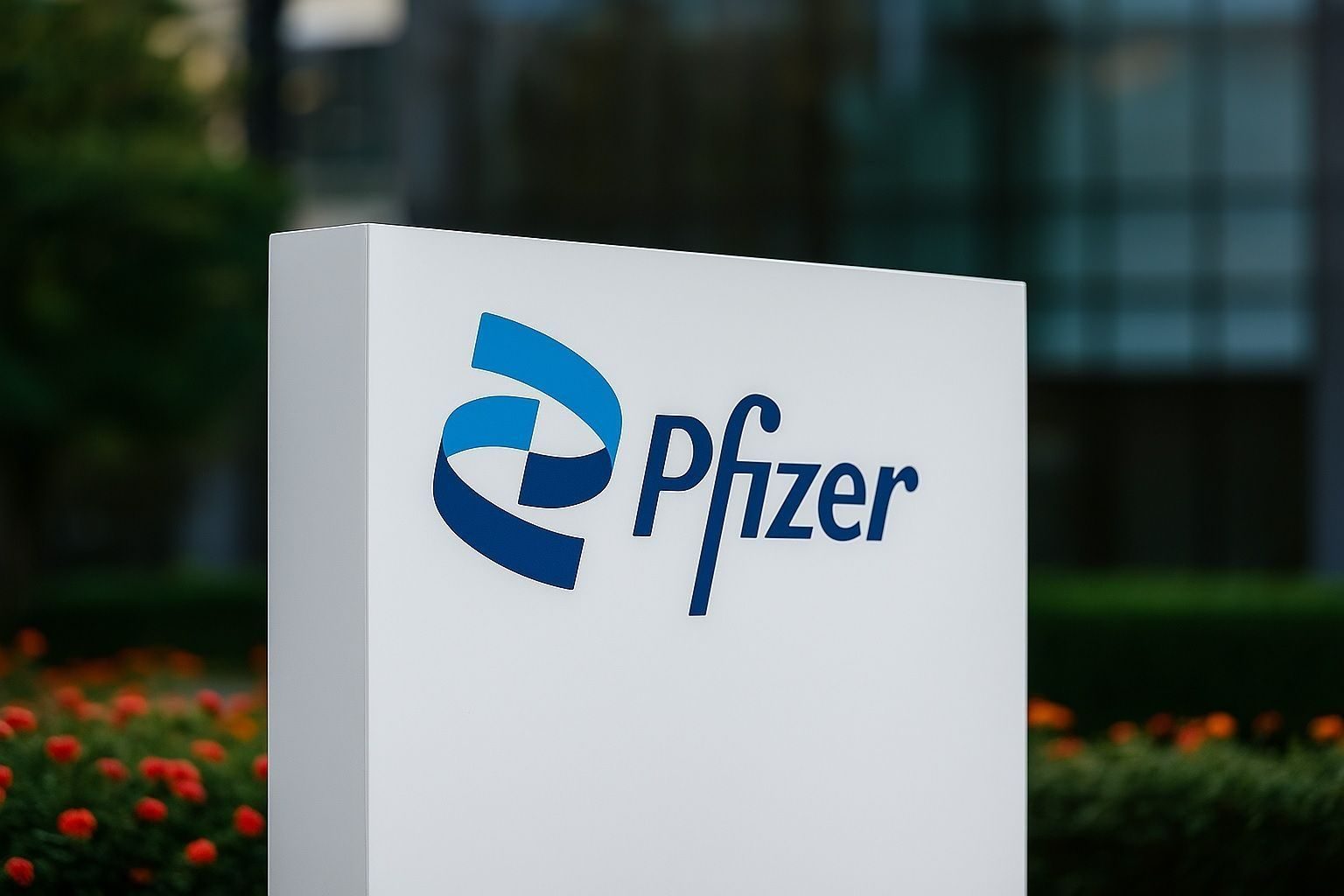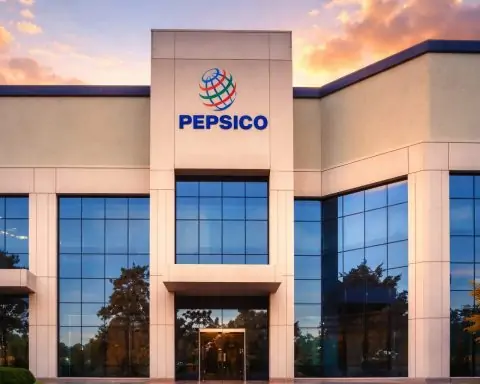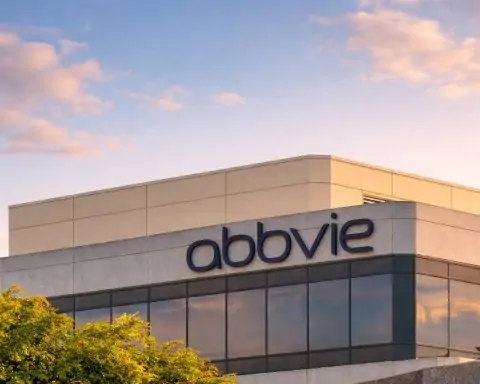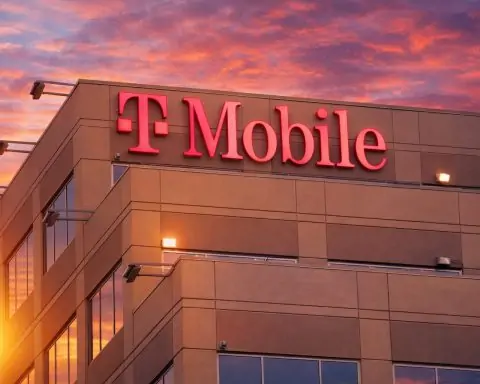Published: November 28, 2025 – mid‑session U.S. trading
Pfizer stock price today: PFE edges higher in midday trade
Pfizer stock (NYSE: PFE) is trading around $25.8 per share in late morning trading on Friday, November 28, 2025, up roughly 0.3% from yesterday’s close near $25.72. [1]
That keeps PFE:
- Just below its recent 52‑week high of $27.69
- Comfortably above its 52‑week low of $20.92 [2]
- At a market capitalization of about $146 billion, on roughly a mid‑teens price‑to‑earnings ratio (~13.7x) and a PEG ratio around 0.8, with a relatively low beta of ~0.54 versus the broader market. [3]
Performance-wise, MarketBeat data show Pfizer is down about 3% year‑to‑date, roughly flat over the last 12 months, but up about 5% in the last month as sentiment has improved following earnings, pipeline news and an obesity‑drug acquisition. [4]
Today’s key Pfizer stock headlines (November 28, 2025)
A wave of new research and institutional‑ownership disclosures has hit the tape today. The most important Pfizer‑related stories dated November 28, 2025 include:
- Guggenheim lifts price target to $35, keeps Buy rating
- On November 24, Guggenheim raised its PFE price target from $33 to $35 and reiterated a Buy rating, citing Pfizer’s obesity strategy after its acquisition of Metsera and the quality of its pipeline. [5]
- Insider Monkey’s write‑up, republished today, highlights Metsera’s “highly differentiated” clinical‑stage obesity candidates, including MET‑097i, a weekly or monthly GLP‑1 receptor agonist about to head into phase 3; MET‑233i, an amylin analog being tested alone and in combination; plus early‑stage oral GLP‑1 and hormone‑based therapies. [6]
- Norges Bank discloses a new $2.27 billion position
- Norway’s sovereign wealth fund, Norges Bank, has reported a new position of 93.65 million Pfizer shares, worth about $2.27 billion, representing roughly 1.65% of the company at the time of the filing. [7]
- Neuberger Berman boosts its stake by 55%
- Asset manager Neuberger Berman Group LLC increased its Pfizer holdings by 55.1% in Q2, adding just over 1.05 million shares and bringing its stake to 2.97 million shares valued at roughly $71.9 million, or ~0.05% of the company. [8]
- Other funds trim exposure, underscoring a mixed institutional picture
- American Century Companies Inc. reduced its Pfizer position by 13.1% in Q2 to about 2.22 million shares. [9]
- Financial Advocates Investment Management cut its stake by 54.6%, selling 18,358 shares and ending the quarter with 15,281 shares. [10]
- Even after these moves, MarketBeat notes that institutional investors collectively hold about 68% of Pfizer’s shares, reflecting deep but not unanimous professional interest in the stock. [11]
- High‑yield dividend story: Pfizer features in “8 Dividend Stocks Every Investor Should Consider”
- A Motley Fool piece syndicated via Nasdaq this morning includes Pfizer among eight dividend stocks to watch, branding it a “high‑yield pharma giant.” The article pegs Pfizer’s dividend yield at about 6.7% and warns that the payout ratio is near 98%, meaning the dividend is heavily exposed to earnings volatility. [12]
- Is Pfizer stock underperforming the Dow?
- A fresh Barchart analysis asks whether Pfizer is lagging the Dow Jones Industrial Average. Over the last three months, the piece notes PFE is up about 3.2%, slightly trailing the Dow’s 4.4% gain, and roughly 3% lower year‑to‑date even as the Dow has advanced by double digits. [13]
- The same article points out that Pfizer’s share price has pulled back about 7% from its 52‑week high but has stayed above both its 50‑day and 200‑day moving averages this month—a sign that technical momentum may be stabilizing after a rough multi‑year slide. [14]
Taken together, today’s news paints a picture of a high‑yield pharma heavyweight that’s still fighting a reputation as a laggard—but is attracting serious long‑term capital and at least one higher‑conviction Wall Street upgrade.
Why Guggenheim turned more bullish: the Metsera obesity bet
Guggenheim’s raised $35 price target is built largely on Pfizer’s renewed push into the obesity and cardiometabolic market. [15]
Key points:
- On November 13, 2025, Pfizer announced it had completed its acquisition of Metsera, Inc., a clinical‑stage biotech focused on next‑generation obesity and cardiometabolic drugs. [16]
- The deal, valued at up to $10 billion depending on milestones, gives Pfizer rights to a portfolio of GLP‑1 and amylin‑based therapies, including MET‑097i (a weekly or monthly injectable GLP‑1), MET‑233i (a monthly amylin analog), plus an oral GLP‑1 candidate and other hormone‑based approaches. [17]
- Analysts and Reuters coverage estimate the global obesity‑drug market could reach around $150 billion annually later this decade, with incumbents Novo Nordisk and Eli Lilly currently dominating. Pfizer’s move is widely seen as an attempt to re‑enter a field it stepped back from after discontinuing its own oral GLP‑1 program over safety concerns. [18]
Guggenheim’s thesis, as summarized in today’s coverage, is that Metsera gives Pfizer a credible second‑generation obesity pipeline just as the first wave of GLP‑1 drugs starts to mature—potentially turning a perceived strategic misstep (dropping its prior obesity pill) into a multi‑billion‑dollar long‑term growth opportunity. [19]
Institutional flows: big money is moving in both directions
Today’s cluster of 13F‑based headlines reinforces how divided large investors remain on PFE:
- Bullish side:
- Norges Bank’s new $2.27 billion position (93.65 million shares) is a strong vote of confidence from one of the world’s largest sovereign wealth funds. [20]
- Neuberger Berman boosting its stake by 55.1% to nearly 3 million shares suggests another long‑term active manager sees value at current levels. [21]
- Bearish or cautious side:
Despite these divergent moves, MarketBeat notes that institutions still control more than two‑thirds of Pfizer’s float (about 68%), underscoring that PFE remains a core, widely held name in large‑cap healthcare portfolios—even if opinions differ on how and when the story improves. [24]
Dividend and valuation: a 6.7% yield that’s too big to ignore
Pfizer’s dividend is front and center in today’s coverage.
- MarketBeat’s institutional‑activity articles recap that Pfizer recently declared a $0.43 quarterly dividend, or $1.72 annually, implying a yield of roughly 6.7% at current prices—among the highest in Big Pharma. [25]
- The same sources flag that this equates to a payout ratio close to 100% of current earnings, meaning essentially all of Pfizer’s profits are being returned to shareholders as dividends. [26]
The Nasdaq/Motley Fool dividend piece published this morning frames Pfizer as a classic high‑yield, high‑risk income play:
- The article calls Pfizer’s 6.7% yield “one of the highest of any blue‑chip stock,” but warns the almost triple‑market yield comes with a near‑triple‑digit payout ratio that leaves little room for earnings hiccups or unexpected pipeline setbacks. [27]
In other words:
- Income investors may be attracted to the steady cash flow and long dividend history.
- Risk‑aware investors will notice that, unless earnings grow meaningfully, the board may eventually have to choose between cutting the dividend or sacrificing growth investments elsewhere in the business.
At today’s price, Pfizer screens as a value stock with an unusually high yield, trading at just under 14x trailing earnings and a PEG ratio below 1, levels that many investors would normally associate with slower‑growth or out‑of‑favor names. [28]
Fundamental backdrop: Q3 earnings, guidance and cost cuts
The news flow today builds on Pfizer’s third‑quarter 2025 earnings, released earlier this month:
- Q3 2025 revenue came in at about $16.65–$16.7 billion, down roughly 6% year over year, reflecting the continued decline of COVID‑19 vaccine and antiviral sales. [29]
- The non‑COVID portfolio still grew, with operational revenue up around 4%, underscoring that Pfizer’s base business is expanding even as pandemic‑related sales fade. [30]
- Adjusted diluted EPS was $0.87, comfortably ahead of consensus estimates (around $0.79), helped by cost savings and a lower effective tax rate. [31]
- Management reaffirmed 2025 revenue guidance of $61–$64 billion and raised full‑year EPS guidance to $3.00–$3.15, from a prior range of $2.90–$3.10. [32]
- Pfizer says it remains on track to deliver about $7.2 billion in net cost savings by 2027, which should help support margins even if top‑line growth stays muted. [33]
For today’s investors, that backdrop matters for two reasons:
- It shows that earnings are currently just high enough to support the outsized dividend and fund acquisitions like Metsera—but with limited cushion if anything goes wrong.
- It suggests that Pfizer is attempting to “earn its way” out of the COVID hangover through a combination of cost discipline, pipeline bets (obesity and oncology) and selective M&A.
Oncology catalyst: PADCEV + Keytruda approval
Another piece of the bullish argument: Pfizer’s expanding oncology franchise, especially after the latest PADCEV + Keytruda news.
- On November 21, 2025, the U.S. FDA approved PADCEV (enfortumab vedotin‑ejfv) plus Keytruda (pembrolizumab) for certain patients with muscle‑invasive bladder cancer who are ineligible for standard cisplatin‑based chemotherapy. [34]
- PADCEV is now described as a Pfizer–Astellas antibody‑drug conjugate (through Pfizer’s acquisition of Seagen) combined with Merck’s Keytruda; oncology specialists have called the perioperative regimen “game‑changing” and potentially a new standard of care based on strong survival benefits in the Keynote‑905 trial. [35]
- Barchart notes that Pfizer’s stock jumped roughly 2.6% on November 21 after the approval, helping push shares to a fresh 52‑week high before a modest pullback. [36]
For investors watching PFE today, PADCEV + Keytruda is important because it:
- Adds to Pfizer’s post‑Seagen oncology growth story
- Helps offset looming patent expirations on legacy blockbusters like Eliquis and Ibrance, which analysts expect to weigh on revenue between 2026 and 2028 [37]
- Reinforces the idea that Pfizer’s investment in antibody‑drug conjugates (ADCs) could be a durable competitive advantage in cancer care.
How Pfizer stock compares to the market right now
The Barchart analysis and MarketBeat performance data together draw a clear contrast between Pfizer and the broader market in 2025: [38]
- 3‑month return:
- Pfizer: +3.2% (approx.)
- Dow Jones Industrial Average: +4.4%
- Year‑to‑date 2025:
- Pfizer: about ‑3%
- Dow: roughly +11%
- Last 12 months:
- Pfizer: essentially flat to slightly negative
- Dow: mid‑single‑digit gain (~5–6%)
Technically, however, the tone has improved:
- PFE has been trading above its 50‑day and 200‑day moving averages since early November, a constructive signal often interpreted as early evidence of a trend reversal rather than a dead‑cat bounce. [39]
On valuation and income:
- Price near $25.8 vs. average analyst price targets around $28–$28.5, implying roughly 10% upside if Wall Street’s consensus plays out. [40]
- Dividend yield ~6.7%, far above both the S&P 500 and most large‑cap pharma peers. [41]
That combination—slight underperformance, high yield, discounted valuation and slowly improving momentum—is exactly why PFE keeps showing up today in screens for value, income and contrarian opportunities.
What today’s news could mean for investors
Putting it all together, the November 28, 2025 picture for Pfizer stock looks like this:
- Short‑term sentiment:
- Slightly positive today, with shares modestly higher following a week that already saw a Guggenheim upgrade, obesity‑pipeline optimism and continuing buzz around the PADCEV + Keytruda approval. [42]
- Ownership & conviction:
- Large institutions are not walking away from Pfizer—if anything, the entry of Norges Bank and increased stake from Neuberger Berman show that some of the most sophisticated investors in the world are willing to commit fresh capital at current levels, even as others trim exposure. [43]
- Risk–reward profile:
- On the reward side, Pfizer offers:
- A very high dividend yield backed (for now) by solid earnings and aggressive cost cuts
- New potential growth drivers in obesity (Metsera) and oncology (PADCEV + Keytruda and broader Seagen assets) [44]
- On the risk side, investors must weigh:
- Patent cliffs for key drugs over the next few years
- Declining COVID‑19 revenue
- A payout ratio near 100%, which leaves limited room for missteps before the dividend or buyback policy might need to be revisited. [45]
- On the reward side, Pfizer offers:
- Analyst stance:
- Data from Barchart and MarketBeat show a mixed but generally cautious outlook: overall ratings cluster around “Hold” to “Moderate Buy,” with price targets only modestly above where the stock trades today. [46]
For traders, the key near‑term catalysts to watch include:
- Any further analyst revisions following today’s institutional‑activity headlines
- Updates on Metsera’s clinical timelines and obesity‑program data
- Early launch and uptake trends for the PADCEV + Keytruda regimen in bladder cancer. [47]
For long‑term investors, Pfizer remains what many of today’s articles describe: a high‑yield, “show‑me” turnaround story. The stock’s 6.7% dividend and sub‑14x earnings multiple are attractive on paper, but the company still has to execute on its pipeline, manage patent expirations and grow beyond COVID‑era peaks to fully justify the bullish case.
Important note: All prices, yields and metrics above are approximate and based on information available as of midday on November 28, 2025. They may change as markets continue to trade. This article is for information and news purposes only and is not financial advice or a recommendation to buy or sell any security.
References
1. www.marketbeat.com, 2. www.marketbeat.com, 3. www.marketbeat.com, 4. www.marketbeat.com, 5. finviz.com, 6. www.insidermonkey.com, 7. www.marketbeat.com, 8. www.marketbeat.com, 9. www.marketbeat.com, 10. www.marketbeat.com, 11. www.marketbeat.com, 12. www.nasdaq.com, 13. markets.financialcontent.com, 14. markets.financialcontent.com, 15. finviz.com, 16. www.pfizer.com, 17. www.insidermonkey.com, 18. www.reuters.com, 19. www.insidermonkey.com, 20. www.marketbeat.com, 21. www.marketbeat.com, 22. www.marketbeat.com, 23. www.marketbeat.com, 24. www.marketbeat.com, 25. www.marketbeat.com, 26. www.marketbeat.com, 27. www.nasdaq.com, 28. www.marketbeat.com, 29. www.businesswire.com, 30. www.businesswire.com, 31. s206.q4cdn.com, 32. www.businesswire.com, 33. www.businesswire.com, 34. www.pfizer.com, 35. www.fiercepharma.com, 36. markets.financialcontent.com, 37. markets.financialcontent.com, 38. markets.financialcontent.com, 39. markets.financialcontent.com, 40. markets.financialcontent.com, 41. www.nasdaq.com, 42. finviz.com, 43. www.marketbeat.com, 44. www.businesswire.com, 45. markets.financialcontent.com, 46. markets.financialcontent.com, 47. www.pfizer.com







